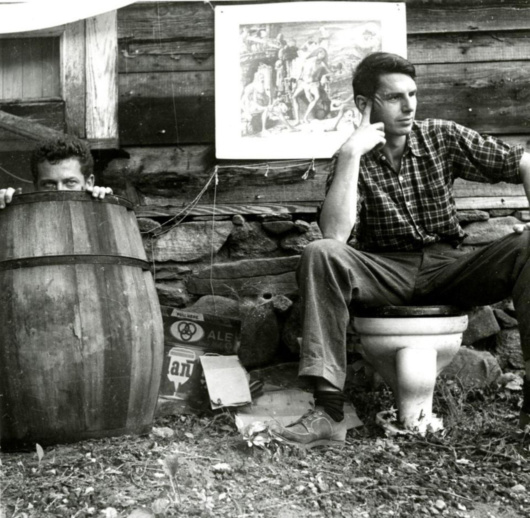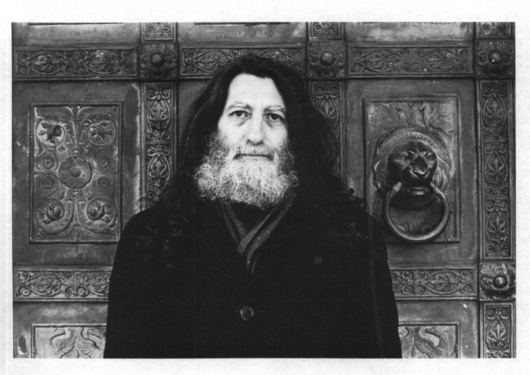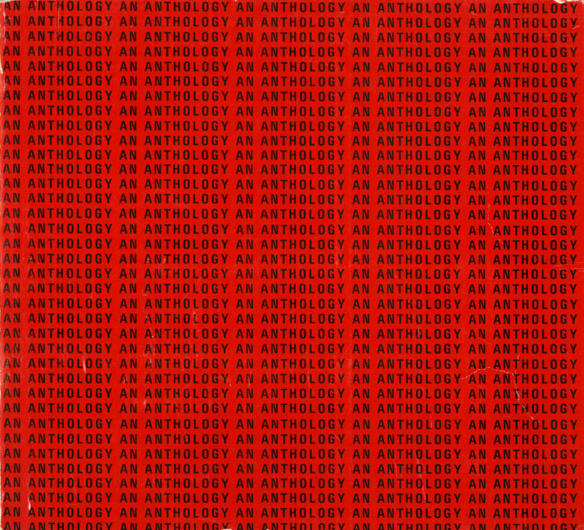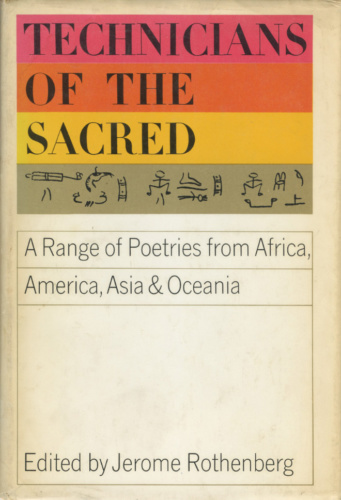Black Mountain
Among the several streams which made up the New American Poetry was a group known as the Black Mountain poets, so named for the experimental college in North Carolina where many of them taught or attended classes in the 1950s. The most prominent of these poets were of course Charles Olson, rector of the college in its last five years, and Robert Creeley, who edited The Black Mountain Review. The work of both has exerted an extraordinary influence on the course of American poetry in the latter half of this century. Closely allied with many of the Black Mountain writers, but especially influential on Creeley, were the poets occasionally known as the Objectivists, such as Louis Zukofsky, George Oppen, and Charles Reznikoff, who were in fact too individualistic to be part of any school. Still, the spare lyricism, historical knowledge, and social conscience found in all three poets were highly regarded in the camps of the New American Poetry.

Robert Creeley and Dan Rice at Black Mountain College, 1955. Photograph by Jonathan Williams.
Those who taught or listened at Black Mountain constitute a veritable roll call of the American avant-garde; among those most relevant to our literary purposes are John Cage, Merce Cunningham, Fielding Dawson, Ed Dorn, Robert Duncan, Buckminster Fuller, Basil King, Joel Oppenheimer, M. C. Richards, Michael Rumaker, John Wieners, and Jonathan Williams. The Black Mountain Review was founded to supplement allied magazines such as Origin (Olson succinctly described the importance of Origin when he told editor Cid Corman, “The thing is, because Origin exists, I write better, I write more…”) [6] and attempted to extend this work by creating a critical grounding for the new writing through the publication of theoretical writings. The magazine also acted as a bridge to writers outside the Black Mountain milieu, publishing work by Lorine Niedecker, James Purdy, Allen Ginsberg, Hubert Selby, Jr., and Jack Kerouac, among others.
Jonathan Williams returned from San Francisco to his home state to study photography with Aaron Siskind and Harry Callahan at Black Mountain College. Williams’s nascent Jargon Society flourished in part as a result of his stay at the college—books published during and just after this period include Olson’s The Maximus Poems, Creeley’s A Form of Women, Louis Zukofsky’s Some Time, Larry Eigner’s On My Eyes, Robert Duncan’s Letters, Denise Levertov’s Overland to the Islands, Paul Metcalf’s Genoa, and Williams’s own Empire Finals at Verona (illustrated by Fielding Dawson), to name just a few. The Black Mountain Review had a distinctive squat format and was very well produced. Published in part as an attempt to draw attention to the college in a last-ditch effort to increase enrollment, the edition size never exceeded 750 copies.
The bringing together of unusual talents from diverse arts in the cloistered setting at Black Mountain played a crucial role in the development of postmodernism later in the 1960s. Having the likes of Buckminster Fuller, John Cage, Merce Cunningham, Robert Rauschenberg, Willem de Kooning, David Tudor, Stefan Wolpe, Paul Goodman, and Cy Twombly (along with the poets mentioned above) under one roof pinpoints the location of one of several influential force fields in America that surely extended the boundaries of the various arts into new kinds of expression and new ways of making art.
Intermedia
New York in the late 1950s saw the emergence of radical changes in dance, painting, film, sculpture, and theater as well as in writing. Indeed, writing or “text” was foregrounded in much of the new art. Language was newly seen as a material form, and could thus be worked with as one would work with paint or movement or sound. Concrete and sound poetry flourished. Conceptual and minimal artists began publishing their works in the form of books (later to be called “artists’ books”)—Edward Ruscha’s early published booklets (for example, Twenty-six Gasoline Stations) were important extenders of the book as an art form. Other artists, such as Dan Graham, Adrian Piper, Sol LeWitt, Vito Acconci, Lawrence Weiner, and Carl Andre, were publishing both artists’ books (i.e., books as works of art) as well as poetry and other writings, sometimes in the same places as those writers most easily identified as poets.
Artist Carolee Schneemann was (and continues to be) crucial in highlighting the value of the ecstatic body as a source of knowledge. Her early performances and films are the source books for much of the performance art that followed in the ’70s. Parts of a Body House Book, published by Beau Geste Press in 1972, connects text and image to ritual, performance, and dream and links her work to that of the writers working in ethnopoetics.

Jackson Mac Low, The Bronx, New York, 1975. Photograph by Gerard Malanga.
John Cage’s influence, in part disseminated through his class in “Composition of Experimental Music” at the New School for Social Research, was crucial in the development of both Happenings and Fluxus. In the summer of 1958, class members included Dick Higgins, Jackson Mac Low, Jim Dine, Allan Kaprow, and George Brecht. Cage’s collection of lectures and writings, entitled Silence, was published in 1961 by Wesleyan University Press. George Maciunas met La Monte Young in Richard Maxfield’s New School class in electronic music. In early 1961, Young and Maciunas hosted a series called “Literary Evenings and Musica Antiqua et Nova” at the latter’s AG Gallery. Participants included Trisha Brown, Yvonne Rainer, Jackson Mac Low, Dick Higgins, and Ray Johnson. In 1960, Young was invited to guest edit an issue of Beatitude East focusing on performance and poetry.

An Anthology of Chance Operations, second edition, edited by La Monte Young (N.p.: Heiner Friedrich, 1970).
The project for Beatitude East was canceled but was resurrected as An Anthology of Chance Operations, edited by Young, designed and produced by Maciunas, and published by Young and Mac Low in 1963. The anthology, a collection of music and performance scores, essays, stories, and poems, included work by Emmett Williams, George Brecht, Henry Flynt, Robert Morris, Terry Riley, Yoko Ono, Simone Forti, Jackson Mac Low, and others. Mac Low’s own work as a writer dates to 1937; he stands, in the words of Jerome Rothenberg, alongside John Cage as “one of the two major artists bringing systematic chance operations into our poetic & musical practice since the Second World War.” [7] His first book, The Twin Plays, was mimeographed in 1963, and was soon followed by The Pronouns in 1964, which was mimeographed at the Judson Memorial Church.
Continue readingThe year 1964 saw the founding of one of the most interesting presses of the period: Dick Higgins’s Something Else Press. As an editor, Higgins seemed to be interested in everything having to do with the new arts—his interest in and knowledge of the history of bookmaking, printing, design, and typography helped him to accomplish something very few of the previously mentioned publishers ever managed to achieve: distribution. One of the most radical achievements of the Something Else Press was to slip avant-garde content into what looked like “regular books” and then to get those books into bookstores and libraries around the world.
The list of titles published by Something Else in its regular series as well as the series of Great Bear Pamphlets is astonishing for its range and depth. A few examples are Daniel Spoerri’s An Anecdoted Topography of Chance, Notations by John Cage with Alison Knowles, An Anthology of Concrete Poetry, edited by Emmett Williams, Breakthrough Fictioneers, edited by Richard Kostelanetz, Store Days by Claes Oldenburg, and Stanzas for Iris Lezak by Jackson Mac Low. It is interesting to note that Higgins’s own first book, What Are Legends, was published by Bern Porter in 1961. Porter, himself an important writer and visual artist, also published the first books of Philip Lamantia and Robert Duncan.
The Deep Image and Ethnopoetics
In the late ’50s and early ’60s, another group important to the New American Poetry was emerging, primarily in New York. They were a sort of “in-between” generation—younger than most of the poets in the Allen anthology but older than the second-generation New York School or the Language poets. This group began publishing in magazines such as Some/thing, Poems from the Floating World, Trobar, Matter, and Caterpillar. Poets most closely allied with this group include Jerome Rothenberg, Robert Kelly, Clayton Eshleman, Diane Wakoski, David Antin, Paul Blackburn, Frank Samperi, Armand Schwerner, and George Economou.
The basic sense of deep image poetry, as distinct from Imagism, was, according to Robert Kelly, to “generate a kind of poetry not necessarily dominated by the images, but in which it is the rhythm of images which forms the dominant movement of the poem.” [8] Jerome Rothenberg would later describe the “deep image” as “a power, among several, by which the poem is sighted & brought close.” Investigations into deep image existed alongside and resonated with work in translation, performance, and an awareness of earlier avant-gardes and poetry from “those anonymous tribal & subterranean predecessors.”
Consequently, these poets were keenly aware of the need to build on the insights and discoveries of Dada and Surrealism. Ethnopoetics developed, in part, out of a growing awareness “that we weren’t just doing something new (which we were) but were getting back in our own terms to fundamental ways of seeing & languaging from which we (the larger ‘we’ of the Western enterprise) had long been cut off.” [9] Thus, ethnopoetics is a recognition of the “primitive” as a way to ease ourselves into the future. Alcheringa: Ethnopoetics, “a first journal of the world’s tribal poetries,” edited by Jerome Rothenberg and Dennis Tedlock, published five numbers in its first series (1970–73) and continued forward with a second series in 1975. Several of the issues contained phonograph records, including readings by Jaime de Angelo, Jackson Mac Low, and Anne Waldman.
New Wilderness Letter (edited primarily by Jerome Rothenberg but with the help of co- and guest editors) extended the ethnopoetics project into an exploration of the relation between old and new forms of art-making across the full spectrum of arts. One of the most interesting issues was New Wilderness Letter 11 (1982), entitied The Book, Spiritual Instrument, which Rothenberg coedited with anthropologist/poet David Guss. A significant contribution to the ethnopoetic project is to be found in the collection of anthologies edited by Rothenberg, including Technicians of the Sacred, Shaking the Pumpkin, America: a Prophecy (with George Quasha), and A Big Jewish Book.
Citations:
6. Sherman Paul, Olson’s Push: Origin, Black Mountain, and Recent American Poetry (Baton Rouge: Louisiana State University Press, 1978), p. 32.
7. Jerome Rothenberg, “Pre-Face,” in Jackson Mac Low, Representative Works: 1938–1985 (New York: Roof, 1986), p. v.
8. Elliott Anderson and Mary Kinzie, eds., The Little Magazine in America: A Modern Documentary History (Yonkers, NY: Pushcart Press, 1978), p. 400.
9. Jerome Rothenberg, Pre-Faces & Other Writings (New York: New Directions, 1981), pp. 52, 139.


